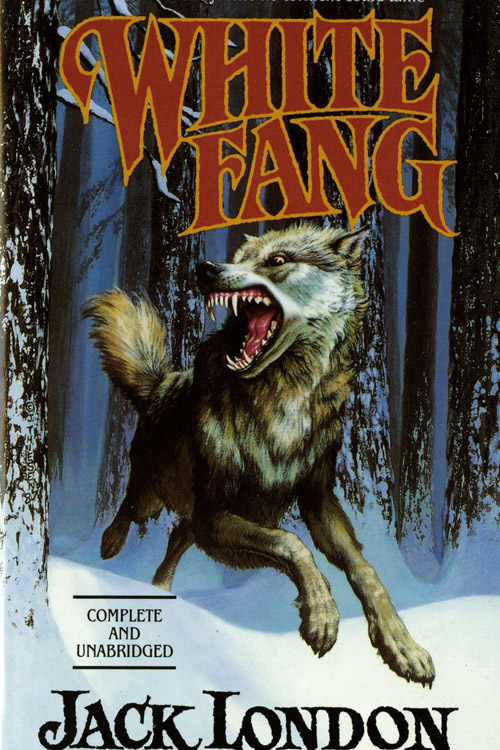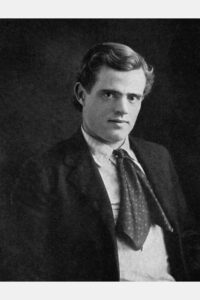
White Fang
The story begins before the wolf-dog hybrid is born, with two men and their sledgedog team on a journey to deliver the coffin of Lord Alfred to a remote town named Fort McGurry in the higher area of the Yukon Territory. A large pack of starving wolves stalks Bill and Henry over several days. Finally, after all of their dogs and Bill have been eaten, more teams find Henry escaping from the wolves; the wolf pack scatters when they hear the large group of people coming. The story then follows the pack, robbed of its last prey. When the pack finally brings down a moose, the famine ends; they eventually split up, and the story now follows a she-wolf and her mate, One Eye. One Eye claimed her after defeating and killing a younger rival.
The she-wolf gives birth to a litter of five pups by the Mackenzie River, and all but one dies from hunger. One Eye is killed by a lynx while trying to rob her den for food for the she-wolf and her pup; his mate later discovers his remains near the lynx’s den. The surviving pup and the she-wolf are left to fend for themselves. Shortly afterwards, the she-wolf kills all the lynx’s kittens to feed her pup, prompting the lynx to track her down, and a vicious fight breaks out. The she-wolf eventually kills the lynx but suffers severe injury; the lynx carcass is devoured over seven days as the she-wolf recovers from her injuries. One day, the pup comes across five indigenous people, and the she-wolf rescues him. One man, Grey Beaver, recognizes the she-wolf as his late brother’s wolfdog, Kiche, who left during a famine. Grey Beaver’s brother is dead, so he takes Kiche and her pup and names the cub “White Fang”. White Fang has a harsh life in the native camp; seeing him as a wolf, the current puppy pack immediately attacks him. The Natives protect him, but the pups never accept him, and the pups’ leader, Lip-Lip, singles him out for persecution.
White Fang becomes a savage, callous, sad, solitary, and deadly fighter, “the enemy of his kind”. At this time, White Fang is separated from his mother, who is sold off to another Native camp by Three Eagles. He realizes how hard life in the wild is when he runs away from camp and earns the respect of Grey Beaver when he saves his son Mit-Sah from a group of boys seeking revenge for White Fang attacking one of them for trying to beat him for no reason. When a famine occurs, he runs away into the woods and encounters his mother, Kiche, only for her to chase him away, for she has a new litter of cubs and has forgotten him. He also encounters Lip-Lip, whom he fights and kills before returning to the camp. When White Fang is five years old, he is taken to Fort Yukon so Grey Beaver can trade with the gold hunters. There, a malicious dog-fighter named “Beauty” Smith connives to get Grey Beaver addicted to whiskey and then, when drunk, sells White Fang to him. White Fang defeats all opponents pitted against him, including several wolves and a lynx, until a bulldog called Cherokee is brought in to fight him. Cherokee has the upper hand in the fight when he grips the skin and fur of White Fang’s neck and begins to throttle him.
White Fang nearly suffocates but is rescued when a rich mining expert, Weedon Scott, stops the fight and forcibly buys White Fang from Beauty Smith. Scott attempts to tame White Fang, and after a long, patient effort, he succeeds. When Scott tries to return to California alone, White Fang pursues him, and Scott decides to take the dog with him back home. In Sierra Vista, White Fang must adjust to the laws of the estate. At the end of the book, an escaped convict, Jim Hall, tries to kill Scott’s father, Judge Scott, for sentencing him to prison for a crime he did not commit, not knowing that Hall was “railroaded”. White Fang kills Hall and nearly kills himself but survives. As a result, the women of Scott’s estate name him “The Blessed Wolf”. The story ends with White Fang relaxing in the sun with the puppies he has fathered with the sheepdog Collie.
Read or download Book
Jack London
John Griffith Chaney (January 12, 1876 – November 22, 1916), better known as Jack London, was an American novelist, journalist and activist.
Biography
A pioneer of commercial fiction and American magazines, he was among the first American authors to become an international celebrity and earn a large fortune from writing. He was also an innovator in the genre later known as science fiction. London was part of the radical literary group “The Crowd” in San Francisco and a passionate advocate of animal rights, workers’ rights, and socialism. London wrote several works dealing with these topics, such as his dystopian novel The Iron Heel, his non-fiction exposé The People of the Abyss, War of the Classes, and Before Adam.
His most famous works include The Call of the Wild and White Fang, both set in Alaska and the Yukon during the Klondike Gold Rush, as well as the short stories “To Build a Fire”, “An Odyssey of the North”, and “Love of Life”. He also wrote about the South Pacific in stories such as “The Pearls of Parlay” and “The Heathen”. On July 12, 1897, London (age 21) and his sister’s husband, Captain Shepard, sailed to join the Klondike Gold Rush. This was the setting for some of his first successful stories. However, London’s time in the harsh Klondike was detrimental to his health. Like many other men malnourished in the goldfields, London developed scurvy. His gums became swollen, leading to the loss of his four front teeth. A constant gnawing pain affected his hip and leg muscles, and his face was stricken with marks that always reminded him of the struggles he faced in the Klondike. Father William Judge, “The Saint of Dawson”, had a facility in Dawson that provided shelter, food, and medicine to London and others. His struggles there inspired London’s short story, “To Build a Fire” (1902, revised in 1908), which many critics assess as his best. His landlords in Dawson were mining engineers Marshall Latham Bond and Louis Whitford Bond, who were educated at the Bachelor’s level at the Sheffield Scientific School at Yale and the Master’s level at Stanford, respectively. The brothers’ father, Judge Hiram Bond, was a wealthy mining investor.
While the Bond brothers were at Stanford, Hiram, at the suggestion of his brother, bought the New Park Estate at Santa Clara and a local bank. The Bonds, especially Hiram, were active Republicans. Marshall Bond’s diary mentions friendly sparring with London on political issues as a camp pastime. London left Oakland with a social conscience and socialist leanings; he returned to become a socialist activist. He concluded that his only hope of escaping the work “trap” was to get an education and “sell his brains”. He saw his writing as a business, his ticket out of poverty, and, he hoped, as a means of beating the wealthy at their own game. On returning to California in 1898, London began working to get published, a struggle described in his novel Martin Eden (serialized in 1908 and published in 1909). His first published story since high school was “To the Man On Trail”, which has frequently been collected in anthologies.[citation needed] When The Overland Monthly offered him only five dollars for it—and was slow paying—London came close to abandoning his writing career. In his words, “literally and literarily I was saved” when The Black Cat accepted his story “A Thousand Deaths” and paid him $40—the “first money I ever received for a story”.






